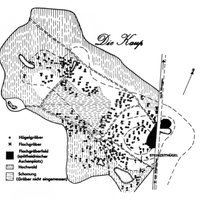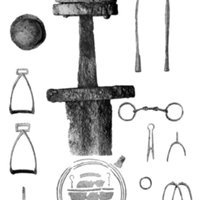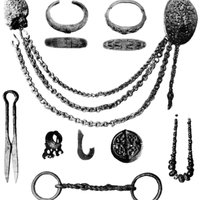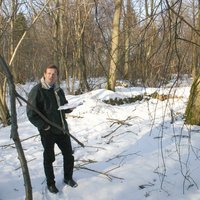The graveyard
The graveyard is located in a little forest with an extension of 400 m x 500 m, lying on a flat ridge of about 10 m above sea level, which originated from the last Ice Age.
Apart from a Stone Age grave mound with four burials, a grave from the Bronze Age and one from the Iron Age in the same mound, as well as several burials from the Roman Period, the forest contains over 500 Viking Age burial mounds with diameters between 3 and 6 m and heights up to 1 m.
Both, cremation and inhumation graves are known in Wiskiauten. In some cases even horse burials have been documented in the graves.
The gravegoods represent typical Scandinavian products. Male graves mostly contain swords, lanceheads, shields and objects of riding equipment, dress accessories are primarily represented by brooches of the horse shoe type/penannular type.
Female graves are equipped with several elements of jewellery. Particularly chains of glass beads and silver pendants, arm and finger rings as well as oval saucer brooches and box shaped fibulae are part of the costume , but household articles as knives, pairs of scissors or keys are not uncommon finds.
The oldest burials of the Viking Age in Wiskiauten go back to the middle of the 9th century A.D., while the youngest are no later than the first half of the 11th century.
Early excavations also brought up several flat graves between the mounds, even though their total number is unknown.
In all, the cemetery of Wiskiauten indicates, particularly due to the presence of female graves, that Scandinavian settlers buried their deceased in a period of 200 years, which can only be explained by a settlement in the direct surrounding.
Especially the excavation results from German times, which were rarely published in contemporary literature, can only be reconstructed nowadays by analysing archive material from the Prussia-Museum.
These documents are expected to bring forward new results on grave construction and are currently under research in a dissertation by the Archeological Museum of Schleswig (Archäologisches Landesmuseum Schleswig, Stiftung Schleswig-Holsteinische Landesmuseen Schloß Gottorf).
They are the key to the understanding of the whole complex in modern research about the settlement.
[top]





